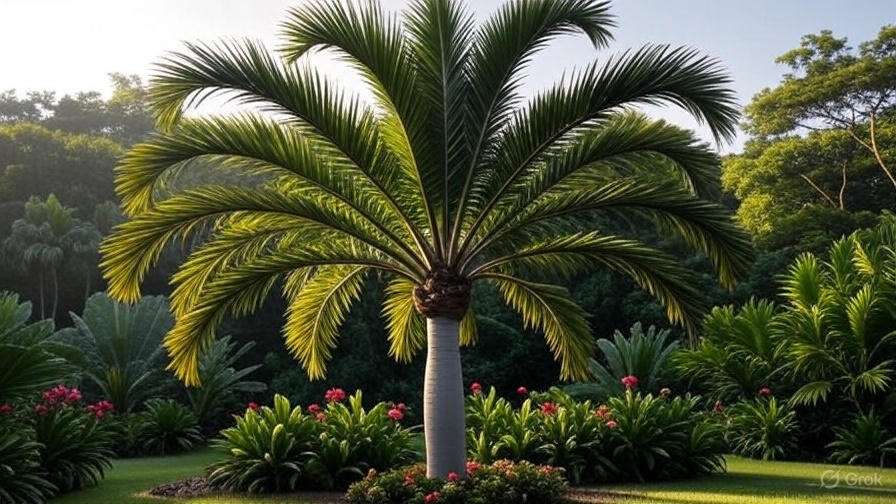
Tree Royal Palm: Essential Care Tips for Thriving Growth and Long-Term Health
The majestic tree royal palm stands tall as a symbol of elegance and beauty in tropical and subtropical landscapes 
In this article, we’ll explore the essential care tips you need to ensure your tree royal palm flourishes year after year. Whether you’re facing issues with its growth, or you’re simply looking to optimize its long-term health, we’ve got the practical advice you need to succeed. Ready to give your tree royal palm the care it deserves? Let’s dive in!
Table of Contents
ToggleUnderstanding the Tree Royal Palm 
The Tree Royal Palm (Roystonea regia) is one of the most stunning and majestic palms you can add to your landscape. With its tall, slender trunk and elegant, feather-like fronds, it’s a favorite choice for gardens, parks, and streetscapes. Known for its striking appearance, the Tree Royal Palm also requires specific care to thrive in your environment. Whether you’re a gardening newbie or an experienced green thumb, here’s everything you need to know to ensure your Tree Royal Palm grows strong and healthy.
What is a Tree Royal Palm? 
A Tree Royal Palm (Roystonea regia) is a striking and majestic tree, known for its tall stature and graceful appearance. Native to the tropical regions of the Caribbean and parts of Central and South America, this palm is a favorite in landscapes where it thrives in warm, sunny environments.
This palm tree can reach heights of up to 60 feet (18 meters), making it an impressive focal point in any garden or outdoor space. With its smooth, silvery-gray trunk and a crown of large, feather-like leaves, the Tree Royal Palm has a unique look that instantly draws attention. It’s often planted for its aesthetic beauty and to add a tropical flair to any setting.
Key Characteristics:
- Height: 40 to 60 feet (12 to 18 meters) tall
- Trunk: Smooth and column-like, with a silver-gray color
- Leaves: Large, feathery, and arching, typically 5 to 8 feet (1.5 to 2.4 meters) long
- Growth Rate: Moderate to fast, depending on care and environmental factors
- Hardiness Zones: USDA 10-11 (best suited for tropical or subtropical climates)
A Tree Royal Palm is perfect for areas that have plenty of sunshine, such as coastal gardens, boulevards, and large outdoor spaces. 
While its beauty is undeniable, it’s also relatively low-maintenance, making it a great option for both experienced gardeners and beginners.
Stay tuned for tips on how to care for your Tree Royal Palm to ensure it thrives for years to come!
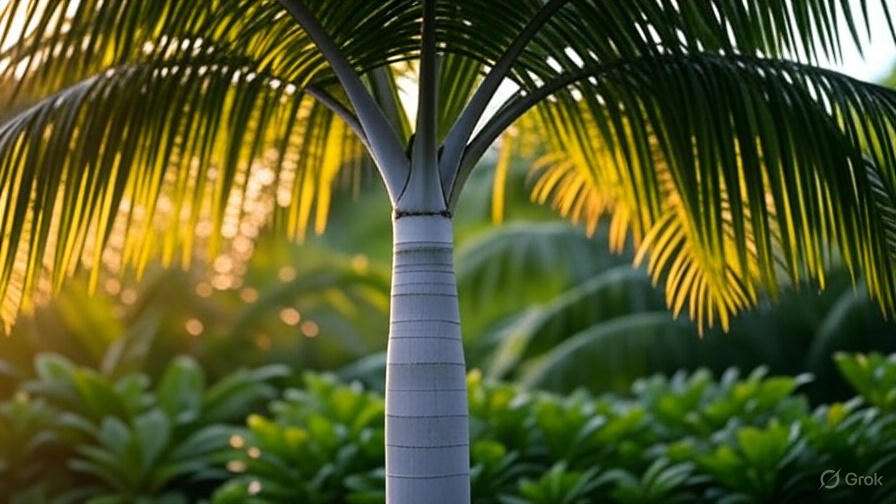
Native Habitat and Growth Features
The Tree Royal Palm is native to tropical regions, particularly around the Caribbean and parts of Central and South America. In its natural environment, it can grow up to 100 feet tall, though it typically reaches around 50–70 feet in cultivated areas. It thrives in warm, humid climates and can tolerate a range of soil types, as long as there’s good drainage.

Why It’s Special 
This palm is recognized for its regal, smooth trunk that tapers gracefully as it rises. Its long, feather-like fronds create a lush, tropical feel. The Tree Royal Palm is a slow grower but makes a big impact as it matures. It’s perfect for creating a dramatic focal point in your garden or a stately avenue in urban settings. With proper care, it can live for decades, adding value and beauty to your outdoor space.
Why It’s Worth the Investment 
The Tree Royal Palm offers long-term beauty and grace. While it may take a few years to reach its full height, it’s worth the wait. Its slender, towering appearance becomes more captivating as the tree matures, making it an excellent investment for anyone looking to elevate their outdoor space. With the right care, this palm can live for over 80 years, providing a timeless tropical ambiance that’s hard to beat.
By understanding the unique needs of the Tree Royal Palm and providing it with the right environment, you can enjoy its beauty for generations to come. Happy gardening!
Ideal Growing Conditions for Tree Royal Palm 
Tree Royal Palms are stunning, majestic plants that can transform any landscape when grown in the right conditions. To help your palm thrive, it’s important to create an environment that matches its needs. Here’s everything you need to know about the ideal growing conditions for your Tree Royal Palm.
1. Sunlight: Full Sunlight is a Must 
Royal Palms love sunlight! They thrive best when exposed to full sun for at least 6 hours a day. This encourages healthy growth and ensures that the leaves stay vibrant and strong.
- Tip: Plant your Tree Royal Palm in a sunny spot with no shading from nearby buildings or trees to help it reach its full potential.
2. Temperature: Warm and Tropical 
Being native to tropical regions, the Tree Royal Palm loves warmth. These palms thrive in temperatures between 75°F (24°C) and 95°F (35°C). They can handle brief periods of cooler weather but struggle with frost.
- Tip: If you live in a cooler climate, consider planting your Tree Royal Palm in a large pot so you can bring it indoors during colder months.
3. Soil: Well-Draining and Slightly Acidic 
Tree Royal Palms do best in soil that is well-draining, as they don’t like to sit in waterlogged soil. They prefer slightly acidic to neutral soil with a pH of around 6.0 to 7.5.
- Tip: Make sure your planting area has good drainage, or consider mixing in sand or perlite to improve drainage if your soil is heavy or clay-based.
4. Watering: Keep It Consistent 
Consistent moisture is key for the Royal Palm. Water it regularly, especially during dry spells, but ensure the soil never becomes waterlogged. While the tree can handle some drought, it grows best when the soil stays moist but not soggy.
- Tip: Water deeply once a week during the growing season and cut back in the winter months when growth slows down.
5. Humidity: Love the Moisture 
Royal Palms are native to areas with high humidity, so they prefer a humid environment. If the air is too dry, the palm’s leaves may turn brown at the edges.
- Tip: If you live in a dry climate, consider misting the leaves regularly or using a humidifier nearby. This helps mimic the palm’s natural environment and keeps it healthy.
6. Space: Give It Room to Grow 
Tree Royal Palms can grow quite tall—up to 50 feet (15 meters)! So, be sure to plant it in a location with plenty of space for its roots and canopy to spread out. Crowded conditions will stunt its growth and reduce airflow, which could lead to disease.
- Tip: Plant your palm at least 6-8 feet (2-2.5 meters) away from structures and other trees to give it the space it needs to thrive.
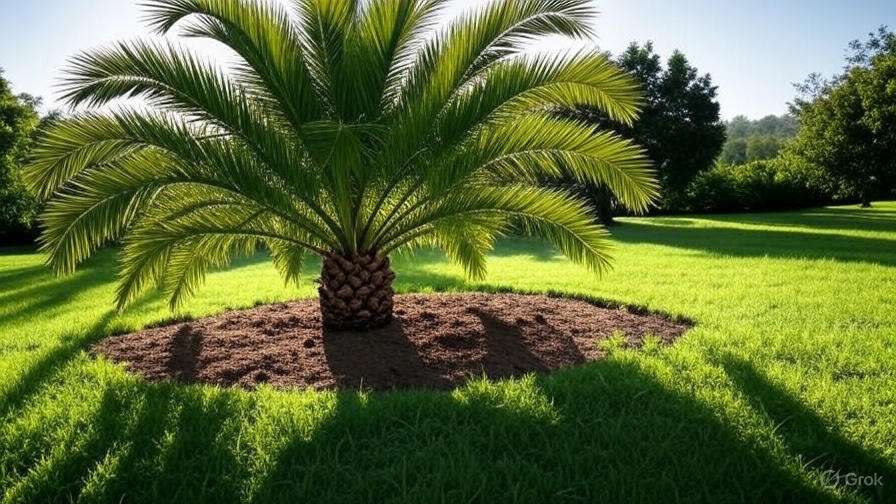
Planting and Transplanting Tree Royal Palms 
Planting and transplanting a Royal Palm tree (Roystonea regia) requires a bit of careful planning, but with the right steps, you’ll be able to enjoy its majestic beauty for years to come. Whether you’re planting a young tree in your garden or moving a mature Royal Palm to a new location, here’s a straightforward guide to ensure success.
1. Choose the Right Location 
Before you dig in, pick a spot with the ideal conditions for your Royal Palm:
- Full Sunlight: These palms love the sun and thrive with at least 6 hours of direct sunlight each day.
- Well-Drained Soil: Royal Palms hate “wet feet,” so ensure the soil drains well. If your soil is clay-heavy, consider improving it with organic compost or plant the tree in a raised bed.
- Space to Grow: Royal Palms are large, so plant them in a spot with enough space for their wide canopy and deep roots. Keep them at least 10 feet away from buildings, fences, and other trees.
2. Planting a Royal Palm 
- Step 1: Dig a Hole
Dig a hole that is about 2-3 times wider than the root ball of your Royal Palm, but no deeper than the root ball’s height. This ensures the roots can spread out comfortably. - Step 2: Prepare the Root Ball
If you’re planting a potted palm, carefully remove it from the container. Gently loosen the roots to encourage outward growth. If you’re planting a bare-root palm, soak the roots in water for a few hours before planting. - Step 3: Position the Palm
Place the palm in the hole, ensuring the top of the root ball is level with the ground. Avoid planting too deep—this can cause the roots to suffocate and lead to poor growth. - Step 4: Backfill and Water
Fill the hole with the soil you dug out, gently packing it down as you go. Water the palm immediately after planting to settle the soil around the roots.
3. Transplanting a Royal Palm 


Transplanting a mature Royal Palm can be a little tricky, but it’s doable with the right steps. Here’s how to do it successfully:
- Step 1: Plan the Timing
The best time to transplant a Royal Palm is during the warmer months, preferably in late spring or early summer, when the tree is actively growing. Avoid transplanting during extreme heat or frost. - Step 2: Digging Around the Palm
When transplanting a larger palm, dig a wide circle around the root ball (at least 2 feet in diameter) to minimize root damage. Take your time, and try to preserve as many roots as possible. - Step 3: Prepare the New Hole
Dig a hole in the new location that’s about 2-3 times wider than the root ball. Ensure the new spot has proper sunlight and drainage. - Step 4: Move and Replant the Palm
Once the palm is free from the ground, carefully lift and move it to its new home. Position it in the hole, making sure it’s at the same depth as it was originally. Fill in the hole with soil, water thoroughly, and support the palm with stakes if needed to prevent it from leaning.
4. Post-Planting Care 
- Watering: Immediately after planting, water the tree thoroughly. During the first few months, water regularly to keep the soil moist but not soggy.
- Mulching: Apply a 2-3 inch layer of mulch around the base to help retain moisture and keep the roots cool.
- Fertilizing: Royal Palms are heavy feeders. After planting, feed them with a balanced, slow-release fertilizer designed for palms. Follow the manufacturer’s instructions to avoid overfeeding.
By following these steps, your Royal Palm will have the best chance to thrive, whether you’re planting a new tree or giving an old one a new home.
Happy planting!
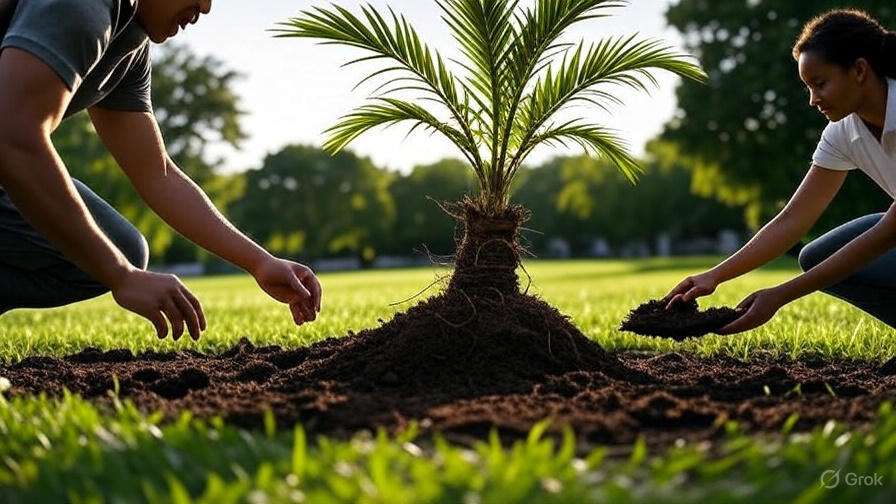
Ongoing Care for Tree Royal Palm 
Caring for your Tree Royal Palm doesn’t stop after planting—consistent attention is key to ensuring its growth and longevity. Here’s a simple guide to help you maintain a healthy and thriving Royal Palm 
1. Watering 
Water is crucial for your Royal Palm, but balance is important. Water the tree regularly, especially during dry spells, but avoid overwatering. Ensure the soil is well-drained; the roots don’t like sitting in waterlogged soil. Typically, deep watering once a week works well, but adjust depending on weather conditions.
2. Fertilizing 
Royal Palms thrive on nutrition. Apply a slow-release, balanced fertilizer every 3 to 4 months. A mix with micronutrients like magnesium and potassium is especially beneficial. During growing season (spring and summer), consider feeding it every 8 weeks to support healthy foliage and growth.
3. Pruning 
Regular pruning helps maintain the palm’s shape and health. Remove dead or damaged fronds to promote better air circulation and prevent disease. But don’t cut too many healthy fronds, as they help the tree produce energy through photosynthesis. Aim for light, selective pruning, focusing on the lower fronds first.
4. Mulching 
Mulch around the base of your Royal Palm to retain moisture, keep the soil temperature stable, and suppress weeds. A 2 to 3-inch layer of organic mulch, like wood chips or coconut coir, will do the trick. Just be sure to keep mulch away from the trunk to prevent rot.
5. Pest Control 
While Royal Palms are fairly resilient, they’re not immune to pests. Watch out for common issues like scale insects or palm weevils. Treat infestations promptly using eco-friendly insecticides or neem oil. Regularly inspect the fronds and trunk for any signs of pests.
6. Climate Considerations 

Royal Palms love warm, tropical climates and can tolerate some light frost. However, they’re best protected from cold temperatures, which can damage their fronds. If you live in a colder area, consider planting your tree in a more sheltered location or using frost cloths during unexpected cold snaps.
7. Re-potting & Transplanting 
If your Royal Palm is growing in a container, repotting every 2 to 3 years is a good idea. Choose a pot slightly larger than the current one to allow room for root growth. If transplanting outdoors, dig a hole twice as wide as the root ball to encourage healthy root expansion.
8. Monitoring for Nutrient Deficiencies 
Keep an eye on your palm for signs of nutrient deficiencies. Yellowing fronds could indicate a lack of potassium or magnesium. If you notice this, a fertilizer boost with the right micronutrients can help restore its vibrant green color.
By following these simple steps for ongoing care, you’ll ensure your Tree Royal Palm thrives for years to come. Healthy palms not only add beauty to your landscape but also create a welcoming atmosphere for your home or garden

Common Pests and Diseases Affecting Tree Royal Palms 
Royal Palms are stunning, resilient trees, but like any plant, they can be susceptible to certain pests and diseases. Knowing what to look for and how to treat these issues will help keep your Royal Palm healthy and thriving for years to come. Let’s dive into the most common pests and diseases that can affect these beautiful trees and how you can handle them with ease.
1. Palm Weevils (Rhynchophorus spp.) 
Palm weevils are one of the most destructive pests to Royal Palms. These insects burrow into the trunk, causing severe damage. Signs of an infestation include wilting fronds, dark streaks, and oozing sap.
Solution:
- Prevention: Keep the base of the palm clear of debris and dead fronds to reduce hiding places.
- Treatment: If you notice symptoms, act fast! You can use insecticidal treatments designed for palm weevils or consult a professional for trunk injection treatments.
2. Scale Insects (Aspidiotus spp.) 
Scale insects look like small, brown bumps on the fronds or stems of your Royal Palm. They suck the sap from the plant, weakening it and causing yellowing leaves. A heavy infestation can lead to defoliation.
Solution:
- Prevention: Regularly inspect your tree and remove any visible scale by wiping the leaves with a damp cloth.
- Treatment: Use horticultural oil or insecticidal soap to eliminate scale insects. In severe cases, a systemic insecticide might be necessary.
3. Mealybugs 
Mealybugs are tiny, white, cotton-like pests that cluster on the fronds and stems of Royal Palms. Like scale insects, they feed on the sap, weakening the tree and potentially spreading diseases.
Solution:
- Prevention: Maintain good hygiene around the tree and regularly check for early signs of infestation.
- Treatment: Spray the affected areas with insecticidal soap or neem oil to control mealybug populations.
4. Fungal Infections 
Fungal diseases, such as Fusarium wilt, can cause yellowing and wilting of the fronds. These infections often appear as brown spots or discoloration along the edges of the leaves. Overwatering or poor drainage can contribute to fungal problems.
Solution:
- Prevention: Ensure your Royal Palm has well-draining soil, and avoid overwatering. Good airflow around the tree is crucial to reduce moisture buildup.
- Treatment: Fungicide applications may be necessary to combat fungal infections, but for severe cases, you may need to remove and dispose of the affected fronds to prevent spreading.
5. Leaf Spot Disease 
Leaf spot diseases, caused by various fungi and bacteria, result in dark, sunken lesions or yellow spots on the leaves. While these spots don’t always kill the tree, they can affect its overall health and appearance.
Solution:
- Prevention: Avoid overhead watering to keep the leaves dry, as wet conditions favor the growth of fungi and bacteria.
- Treatment: Remove and dispose of infected leaves, and apply fungicides if the problem persists.
6. Root Rot 
Root rot is a serious condition caused by overwatering or poor drainage. It leads to the decay of the roots, causing the tree to weaken and eventually die. Symptoms include yellowing leaves, drooping fronds, and a stunted growth rate.
Solution:
- Prevention: Make sure your Royal Palm is planted in well-draining soil. Avoid standing water around the root zone.
- Treatment: If caught early, you can treat root rot with fungicide and reduce watering. In severe cases, replanting the tree in fresh, well-drained soil may be necessary.
7. Caterpillars 
Certain caterpillar species love to munch on the fronds of Royal Palms, causing holes and damage. While these pests are often seasonal, they can be quite damaging if left unchecked.
Solution:
- Prevention: Regularly inspect your tree for caterpillars, especially during the growing season.
- Treatment: Handpick any caterpillars you find or use an organic insecticide like Bt (Bacillus thuringiensis) to eliminate them without harming beneficial insects.
Final Tips for a Healthy Royal Palm 
- Regular Maintenance: Keep your Royal Palm clean and well-pruned. This helps prevent pests and diseases from gaining a foothold.
- Proper Care: Ensure your palm is planted in well-draining soil, receives adequate sunlight, and is watered appropriately to keep it strong and less susceptible to issues.
- Monitor Regularly: Inspect your tree frequently for any signs of pests or disease. The sooner you catch a problem, the easier it is to treat.
By staying vigilant and practicing good care, your Royal Palm can remain healthy and vibrant, adding beauty to your landscape for years to come!
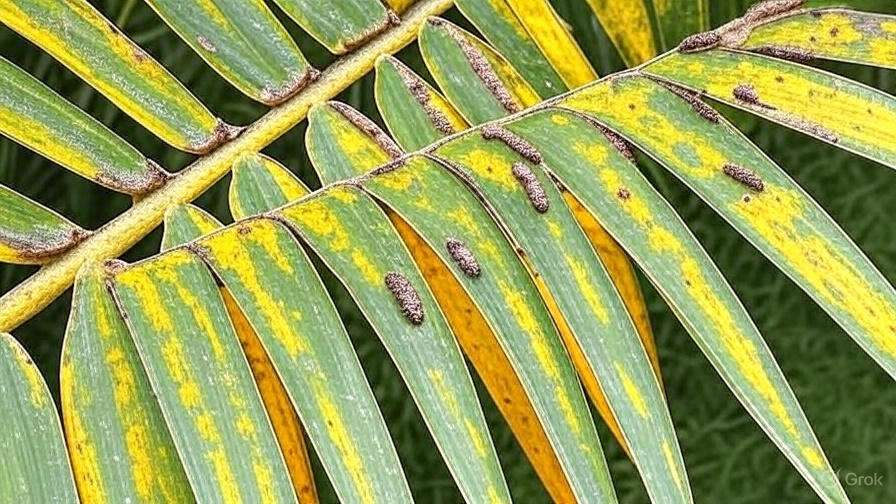
Troubleshooting Common Issues with Tree Royal Palm 
Caring for your Tree Royal Palm can sometimes feel tricky, especially when it doesn’t thrive as expected. Don’t worry – common issues are easy to spot and resolve. In this section, we’ll cover the most frequent problems and provide practical solutions to get your palm back on track.
1. Yellowing Leaves (Chlorosis) 
Why it happens:
Yellow leaves are a common sign of nutrient deficiencies, especially nitrogen, iron, or magnesium. Overwatering or poor drainage can also contribute to chlorosis.
How to fix it:
- Check watering habits: Make sure your tree isn’t sitting in waterlogged soil. Let the soil dry out a bit before watering again.
- Fertilize: Use a balanced fertilizer rich in iron or magnesium, which can help prevent nutrient deficiencies.
- Improve soil drainage: If the soil is too heavy or compacted, consider aerating it to allow better water flow.
2. Browning Tips on Leaves 
Why it happens:
Brown leaf tips are usually a sign of underwatering, excessive salt buildup, or high temperatures.
How to fix it:
- Water consistently: Ensure your palm gets enough water, especially during dry spells, but avoid soaking the soil.
- Leach salt buildup: Occasionally flush the soil with water to remove excess salts. Be sure the water drains properly.
- Provide shade during heat: If your area experiences extreme heat, consider providing your tree with partial shade to protect it from sunburn.
3. Pests and Insects 
Why it happens:
Common pests like spider mites, mealybugs, and scale insects can damage your Tree Royal Palm, causing spots, discoloration, or leaf drop.
How to fix it:
- Inspect regularly: Check the undersides of leaves and stems for small pests. If you find any, gently wipe them off with a damp cloth.
- Use natural pest control: Neem oil or insecticidal soap can be effective against many pests without harming the plant. Apply according to package instructions.
- Prune damaged parts: If infestations are severe, trim affected leaves to prevent the pests from spreading.
4. Drooping Leaves 
Why it happens:
Drooping can occur due to a variety of reasons, such as root damage, overwatering, or nutrient deficiencies.
How to fix it:
- Check the roots: Gently remove the plant from its pot and inspect the roots. If they’re rotting (brown or mushy), trim them and repot the palm in fresh, well-draining soil.
- Adjust watering: Ensure you’re watering at the right intervals – neither too much nor too little.
- Nourish the plant: Fertilizing can also help revive the tree. Use a slow-release, balanced fertilizer to promote overall health.
5. Stunted Growth 
Why it happens:
Slow or stunted growth can result from nutrient imbalances, poor light conditions, or root-bound pots.
How to fix it:
- Ensure proper light: Tree Royal Palms prefer bright, indirect light. If your tree isn’t getting enough light, consider moving it to a sunnier spot.
- Repot if necessary: If the tree’s roots have outgrown their pot, repot it into a larger container to encourage healthy growth.
- Fertilize: Provide your palm with the nutrients it needs by applying a high-quality, slow-release fertilizer.
6. Brown or Soft Spots on the Trunk 
Why it happens:
Brown or soft spots on the trunk can be a sign of fungal infection, root rot, or physical damage.
How to fix it:
- Prune infected areas: Remove any soft, mushy spots carefully to stop the infection from spreading.
- Treat with fungicide: Apply a fungicide to the affected areas, following the product’s instructions to prevent further damage.
- Improve air circulation: Ensure your tree has plenty of airflow around the trunk, especially in humid conditions, to reduce the risk of fungal growth
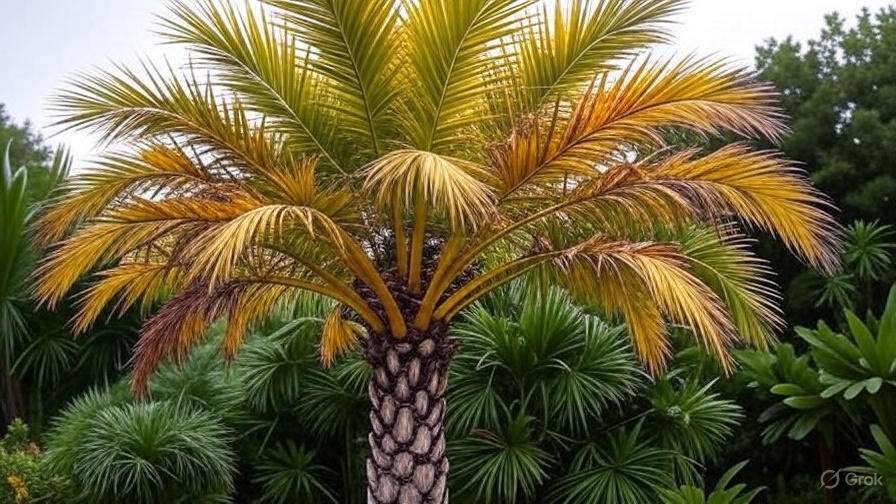
Final Tips for a Healthy Tree Royal Palm 
- Routine checks: Regularly inspect your palm for early signs of stress or pests. The earlier you spot an issue, the easier it is to fix!
- Consistency is key: Stick to a consistent watering, fertilizing, and pruning routine for optimal growth.
- Don’t overcomplicate it: Keep it simple – give your Tree Royal Palm the right environment, and it will thrive.
With a little attention and care, your Tree Royal Palm will grow strong and healthy, bringing beauty and elegance to your space.

Conclusion 
Caring for your tree royal palm is a rewarding endeavor that can lead to a stunning, resilient tree standing tall in your garden or landscape. By understanding the tree’s unique needs—from the ideal planting conditions to regular maintenance and pest prevention—you can ensure that your palm thrives for years to come.
By following the essential care tips outlined in this guide, you’ll have everything you need to address common challenges, maintain healthy growth, and enjoy the beauty of your tree royal palm. Remember, consistency is key—whether it’s watering, fertilizing, or pruning, small actions will lead to big rewards.

Start implementing these steps today, and you’ll soon see your tree royal palm flourishing and becoming the centerpiece of your outdoor space.
Frequently Asked Questions(FAQ)
1. How fast does a tree royal palm grow?
Tree royal palms grow at a moderate pace, typically reaching 2 to 3 feet in height per year under optimal conditions. This growth rate can vary depending on climate, soil quality, and care.
What is the best soil for a tree royal palm?
Tree royal palms thrive in well-draining, sandy loam soil with a slightly acidic to neutral pH (6.0 to 7.0). Good drainage is crucial to avoid root rot, so make sure the soil doesn’t retain too much water.
How often should I water my tree royal palm?
Water your tree royal palm deeply once a week, ensuring the soil stays evenly moist but not soggy. During dry spells, you may need to water more frequently, but always check the soil moisture before adding more water.
Can I grow a tree royal palm indoors?
While tree royal palms prefer outdoor environments, they can be grown indoors in large pots with enough sunlight. Be sure to provide bright, indirect light and a humid environment to mimic tropical conditions.
Why are the leaves of my tree royal palm turning yellow?
Yellowing leaves can be a sign of water stress, nutrient deficiencies, or pests. Check for signs of underwatering, overwatering, or nutrient imbalances, and consider adjusting your care routine or fertilizing with a palm-specific formula.
How do I prune my tree royal palm?
Prune only dead or damaged fronds to maintain the tree’s health and appearance. Avoid cutting healthy fronds, as this can stress the palm and affect its growth. Always use clean, sharp pruning tools to prevent infections.
How do I prevent pests on my tree royal palm?
To prevent pests, maintain proper watering and soil drainage, as stressed trees are more susceptible to infestations. Regularly inspect for common pests like scale insects or mealybugs, and treat infestations with insecticidal soap or neem oil.
Can I transplant a tree royal palm?
Yes, but transplanting a tree royal palm should be done with care. It’s best to transplant during the warmer months, ensuring the tree has enough time to establish its roots before cooler weather. Be sure to handle the roots gently and provide a stable, well-draining environment at the new location.


